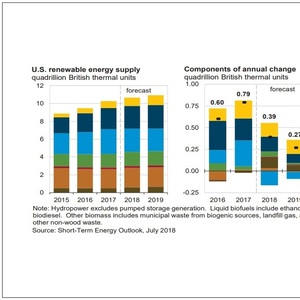EIA updates short-term bioenergy capacity, generation estimates




U.S. Energy Information Administration
July 10, 2018
BY Erin Voegele
The U.S. Energy Information Administration has released the July edition of its Short-Term Energy Outlook, predicting that nonhydropower renewables will provide more than 10 percent of electricity generation this year, up from slightly less than 10 percent last year. In 2019, electricity generation from nonhydropower renewables is expected to reach nearly 11 percent.
Waste biomass is expected to be used to generate approximately 117,000 MWh per day this year, increasing to 119,000 MWh per day next year. Wood biomass is expected to be used to generate 59,000 MWh per day in both 2018 and 2019.
In the electric power sector, total biomass generation is expected to reach 90,000 MWh per day this year, increasing to 92,000 MWh per day next year. This includes 50 MWh per day from waste biomass in both 2018 and 2019, along with 40 MWh per day from wood biomass in 2018, increasing to 42,000 MWh per day next year.
Across other sectors, biomass generation is expected to reach 87,000 MWh per day this year, remaining level in 2019. This includes 77,000 MWh per day from waste biomass and 9 MWh per day from waste biomass in both 2018 and 2019.
Advertisement
Advertisement
The electric power sector is expected to consume 0.305 quadrillion Btu (quad) of waste biomass this year, falling to 0.304 quad next year. The sector is also expected to consume 0.237 quad of wood biomass this year, increasing to 0.249 quad next year.
The industrial sector is expected to consume 0.179 quad of waste biomass this year, falling to 0.176 quad next year. Consumption of wood biomass by the sector is also expected to fall, from 1.45 quad this year to 1.413 quad next year.
The commercial sector is expected to consume 0.126 quad of waste biomass this year, increasing to 0.187 quad next year. Consumption of wood biomass by the sector is expected to reach 0.084 quad in both 2018 and 2019.
Advertisement
Advertisement
The residential sector is expected to consume 0.405 quad of wood biomass in 2018, increasing to 0.42 quad in 2019.
Across all sectors, consumption of waste biomass is expected to reach 0.601 quad this year, increasing to 0.667 quad next year. Consumption of wood biomass, however, is expected to fall slightly, from 2.177 quad in 2018 to 2.166 quad in 2019.
Total U.S. biomass generation capacity in the electric power sector is expected to reach 7,364 MW by the end of 2018, up from 7,318 MW at the end of 2017. In 2019, biomass capacity is expected to increase again, reaching 7,526 MW. Waste biomass capacity is expected to reach 4,284 MW this year, up from 4,239 MW in 2017, and increasing to 4,288 MW in 2019. Wood biomass capacity is expected to reach 3,079 MW this year, level with 2017, but increase to 3,238 MW by the end of 2019.
Across other sectors, total biomass generation capacity is expected to reach 6,645 MW this year, down from 6,661 MW last year. Capacity is expected to fall to 6,637 MW by the end of next year. Waste biomass capacity is expected to reach 876 MW this year, level with 2017, but increase to 892 MW in 2019. Wood biomass capacity is expected to reach 5,769 MW this year, down from 5,785 MW in 2017, and falling to 5,745 MW by the end of 2019.
Upcoming Events





